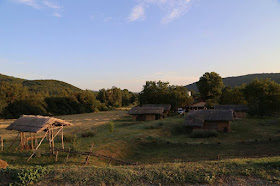One of several similar cult models of a loaf of bread, from the Neolithic Vinča culture. This one was found at Banjica-Usek archaeological site in Belgrade, capital of Serbia, and was dated to 4500 BC. Length 18 cm, width 6 cm. Collection of Belgrade City Museum...
Here is another one...
From this post ritual hiding behind giant breads and about Neolithic Newgrange temple from Ireland and a very strange similarity between its entrance stone and this votive bread...
Einkorn and emmer wheat were an important part of the diet of ancient Vinča-culture. Cereals were ground using small quern-stones and the flour was made into dough which was then baked in ovens found in every Vinča house...
Photograph of the excavation of the Vinča Belo Brdo site, showing archaeologist Miloje Vasić standing next to a clay oven "in situ" and local villagers employed as excavators standing in the background. Early 20th c.
Are you an experimental archaeology fan? Do you want to know how to make Neolithic Vinča culture style bread oven? And Bake bread in it? If you are any of the above, then this paper entitled "Late Neolithic ovens in central Balkans region" is a must...
This is Pločnik archaeological site in Toplica District, Serbia. The 120 hectare settlement was built by people of the Neolithic Vinča culture around 5500 BCE and was used for 800 years, until it was destroyed by fire in 4700 BC...
Local archaeologists reconstructed several houses and created a small replica neolithic village...
The houses are equipped with the replicas of furniture, figurines and bread ovens found during the excavation...
Local archaeologists use the archaeo village to run educational programs for kids. During one of these programs kids were thought how to make bread "neolithic style"...
Kids absolutely love kneading dough and making flat bread patties...
These are then placed in clay ovens, baked and then eaten by children themselves...
BTW, Vinča culture guys inherited their obsession with bread from the ancestral Starčevo culture. These where the guys who adopted grain agriculture, originally developed in the climate of the fertile crescent, for the European climate...
I wrote and article about one of their sites, Blagotin, where a temple dedicated to grain was found with many votive clay grain seeds...

















You have written about oak acorns, are there any signs of acorn bread at Vinca or Balkans? The Natufians mixed different foods in their bread. In Italy, flatbread is pizza, in Hebrew pita, and in Australia a waterfern spore flatbread is called pita-ru ("always pounding"). Grinding stones at a 60,000 year old site in Australia might indicate flour grinding.
ReplyDeleteHi— what is the stone object that sits on the white stand at the center of the last photo on this page? Thanks.
ReplyDeleteIt's all explained in the post about Blagotin. The link is above the picture. Archaeologists who excavated the site believe these are votive clay grain seeds
DeleteThanks. I asked because I found an object on my property that is identical to the one in the exact middle of the last photo here. It is even the same color. It is not explained by the presence of the cultures known to have been here. I also have two monoliths on this property that are the same shape as one I’ve only seen a photograph of in one other place— Vinca-Belo brdo. My property is a long way from Serbia, though, so it doesn’t make much sense.
Delete